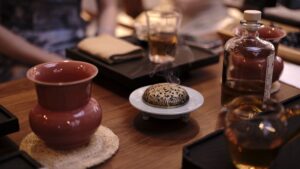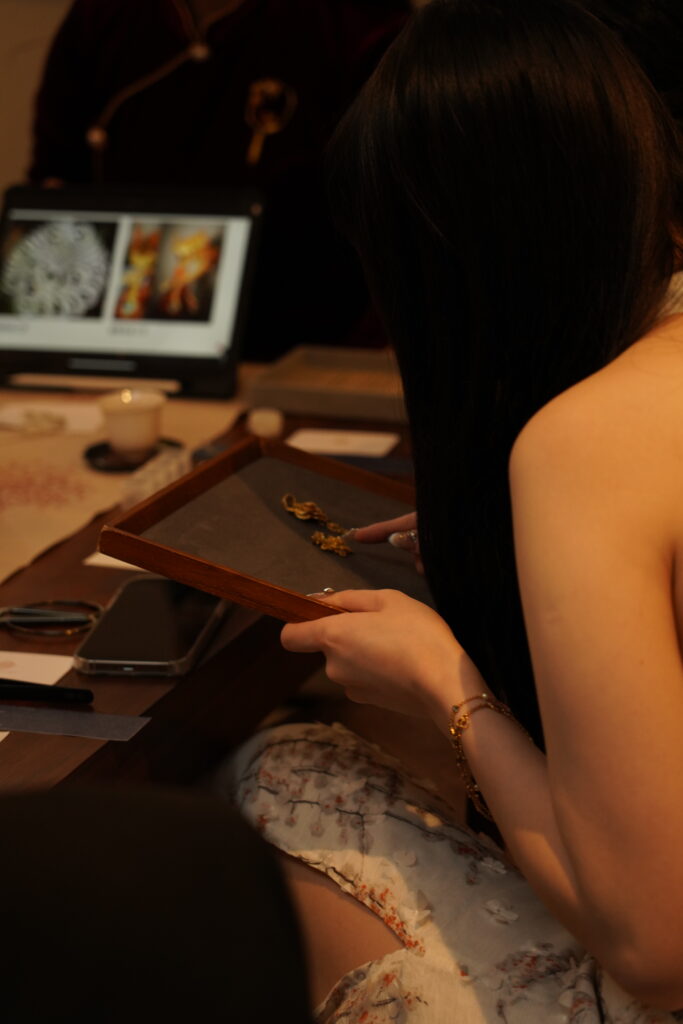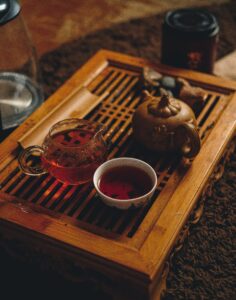
Experience the Art of Chinese Incense and Tea: Exclusive Custom Courses
Experience the Art of Chinese Incense and Tea: Exclusive Custom Courses “Light the incense, brew the tea, hang the paintings, and insert flowers. These four
On May 14th, JY House had the pleasure of hosting a bespoke filigree private experience event themed “Chinese Gardens • Suzhou Jiangnan”. This event was co-organised by ZOEY FILIGREE and Cai Guo Tang采菓堂, and received positive feedback from all the participating guests.
For the event, JY House served high-quality teas such as Baihao Yinzhen (Silver Needle) and aged Da Hong Pao for guests to enjoy in a comfortable atmosphere during the experience activity.
Filigree inlay is a specialty of the ZOEY FILIGREE jewelry studio. The event was led by Zoey, an inheritor of this intangible cultural heritage, who shared the history of this unique craft, allowing participants to experience the joy of “turning gold into silk, and intricately knotting it”. This event brought the treasures of Chinese craftsmanship to a new audience and practitioners in London.


Filigree inlay is one of the “Eight Unique Skills of Beijing”, and is also a national intangible cultural heritage protection project. It has a long history of heritage and a unique royal charm. The exquisite artistic value, ingenious craftsmanship, and valuable classical collections of filigree inlay have attracted considerable attention in contemporary society.
The traditional skill of filigree inlay has been passed down and developed for over 3000 years. As early as the Shang and Zhou dynasties, the craftsmanship of fine gold existed and had a very high technical level. Some of the fine gold objects and gold ornaments unearthed from the tombs of the Shang and Zhou dynasties are early forms of filigree inlay. Since the Han and Tang dynasties, with the prosperity and stability of the economy and society, the widespread use of gold objects and jewelry has been continuously improved, gradually becoming the material pursuit of the upper-class nobles.
The development of the gold industry and smelting technology in the Tang Dynasty drove the maturity and refinement of gold-making craftsmanship. In the official workshops of the Tang Dynasty, there were professional “fine carving craftsmen”. Apprentices needed at least four years to learn a variety of technical skills related to gold, such as gold casting, gold beating, gold plating, gold weaving, gold overlaying, gold powdering, gold twisting, gold annealing, gold circling, gold attaching, gold inlaying, and many others. Most of these techniques are still being passed down to this day. Many of the gold objects unearthed from the Tang Dynasty reveal one or more techniques used in today’s filigree inlay, such as hammering, engraving, filigree, hollowing out, inlaying, granulation, welding, and gilding. In addition, the patterns of the Han and Tang Dynasty gold objects have also laid an important foundation for the development of filigree inlay patterns.

Experience the Art of Chinese Incense and Tea: Exclusive Custom Courses “Light the incense, brew the tea, hang the paintings, and insert flowers. These four

Fridays Free Tea Tasting You are cordially invited to our August Fridays Free Tea Tasting sessions at JY House London! Immerse yourself in the enchanting

Saturday Tea Ceremony Experience – Embrace the Aroma and Serenity JY House London invites you to join our Tea Ceremony Experience! In this special event,